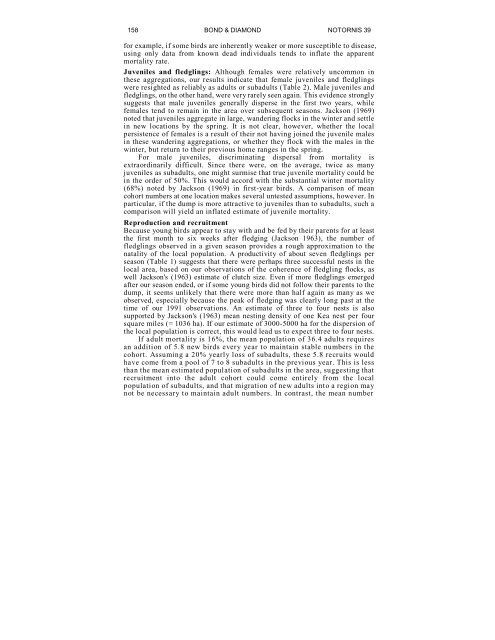NOTORNIS - Kea Conservation Trust
NOTORNIS - Kea Conservation Trust
NOTORNIS - Kea Conservation Trust
You also want an ePaper? Increase the reach of your titles
YUMPU automatically turns print PDFs into web optimized ePapers that Google loves.
158 BOND & DIAMOND <strong>NOTORNIS</strong> 39<br />
for example, if some birds are inherently weaker or more susceptible to disease,<br />
using only data from known dead individuals tends to inflate the apparent<br />
mortality rate.<br />
Juveniles and fledglings: Although females were relatively uncommon in<br />
these aggregations, our results indicate that female juveniles and fledglings<br />
were resighted as reliably as adults or subadults (Table 2). Male juveniles and<br />
fledglings, on the other hand, were very rarely seen again. This evidence strongly<br />
suggests that male juveniles generally disperse in the first two years, while<br />
females tend to remain in the area over subsequent seasons. Jackson (1969)<br />
noted that juveniles aggregate in large, wandering flocks in the winter and settle<br />
in new locations by the spring. It is not clear, however, whether the local<br />
persistence of females is a result of their not having joined the juvenile males<br />
in these wandering aggregations, or whether they flock with the males in the<br />
winter, but return to their previous home ranges in the spring.<br />
For male juveniles, discriminating dispersal from mortality is<br />
extraordinarily difficult. Since there were, on the average, twice as many<br />
juveniles as subadults, one might surmise that true juvenile mortality could be<br />
in the order of 50%. This would accord with the substantial winter mortality<br />
(68%) noted by Jackson (1969) in first-year birds. A comparison of mean<br />
cohort numbers at one location makes several untested assumptions, however. In<br />
particular, if the dump is more attractive to juveniles than to subadults, such a<br />
comparison will yield an inflated estimate of juvenile mortality.<br />
Reproduction and recruitment<br />
Because young birds appear to stay with and be fed by their parents for at least<br />
the first month to six weeks after fledging (Jackson 1963), the number of<br />
fledglings observed in a given season provides a rough approximation to the<br />
natality of the local population. A productivity of about seven fledglings per<br />
season (Table 1) suggests that there were perhaps three successful nests in the<br />
local area, based on our observations of the coherence of fledgling flocks, as<br />
well Jackson's (1963) estimate of clutch size. Even if more fledglings emerged<br />
after our season ended, or if some young birds did not follow their parents to the<br />
dump, it seems unlikely that there were more than half again as many as we<br />
observed, especially because the peak of fledging was clearly long past at the<br />
time of our 1991 observations. An estimate of three to four nests is also<br />
supported by Jackson's (1963) mean nesting density of one <strong>Kea</strong> nest per four<br />
square miles (= 1036 ha). If our estimate of 3000-5000 ha for the dispersion of<br />
the local population is correct, this would lead us to expect three to four nests.<br />
If adult mortality is 16%, the mean population of 36.4 adults requires<br />
an addition of 5.8 new birds every year to maintain stable numbers in the<br />
cohort. Assuming a 20% yearly loss of subadults, these 5.8 recruits would<br />
have come from a pool of 7 to 8 subadults in the previous year. This is less<br />
than the mean estimated population of subadults in the area, suggesting that<br />
recruitment into the adult cohort could come entirely from the local<br />
population of subadults, and that migration of new adults into a region may<br />
not be necessary to maintain adult numbers. In contrast, the mean number












